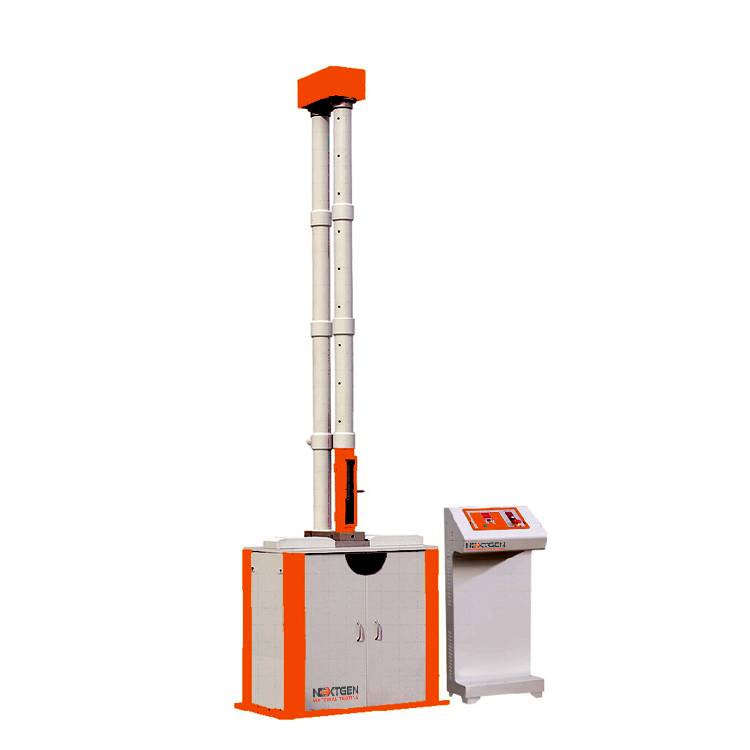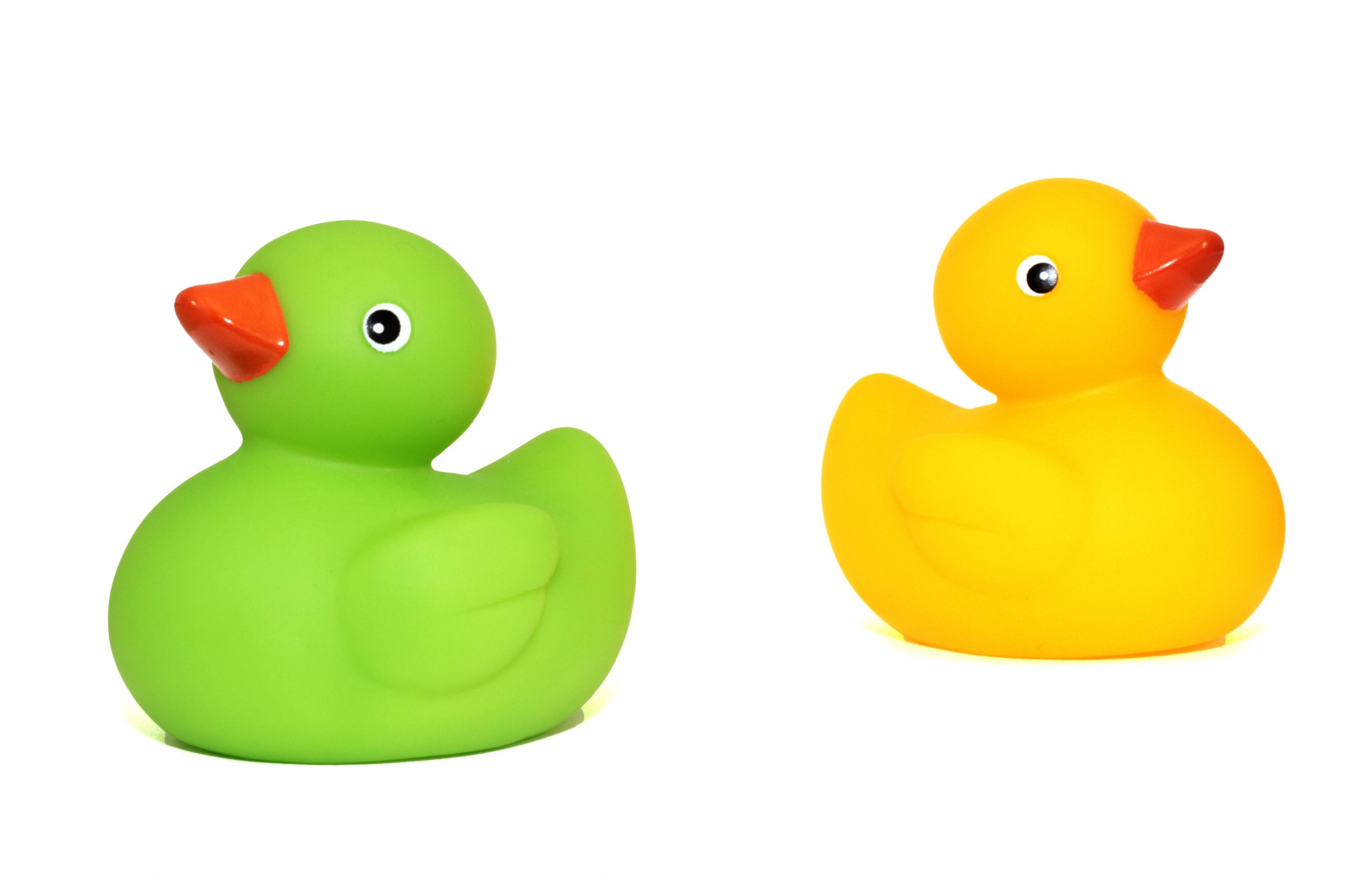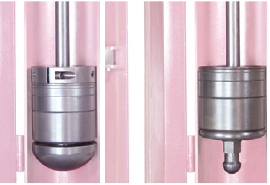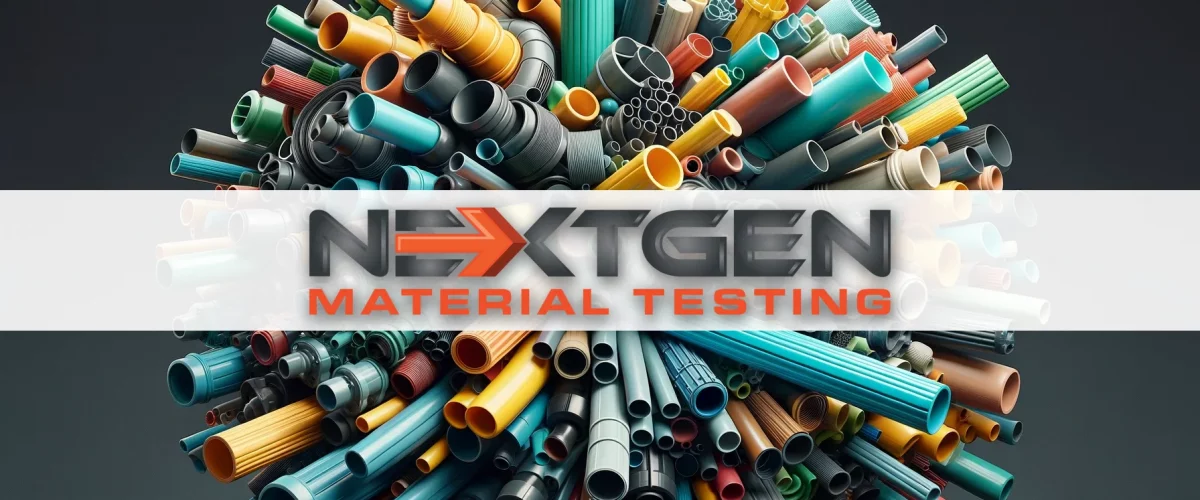Many of us are already aware that material testing includes a broad range of methods. There are many different types of testing for these materials, including tensile tests, hardness tests, fatigue tests, and impact tests, among others. Tests such as impact determine the material’s resilience to sudden stress, identifying its toughness or brittleness. Material tests are indispensable for materials like metals, polymers, ceramics, and composites, particularly in the aerospace, automotive, and construction industries.
In this blog, we discuss our new NG-ImpactFall – Falling Weight Impact Tester, designed to determine the external impact strength of non-metal materials such as plastic pipes, boards, and plastics in general. The NG-ImpactFall material tester is designed to handle an extensive range of plastic pipe types, aligning with key industry standards while delivering precision and adaptability.
We will explore the NG-ImpactFall Falling Weight Impact Tester in detail. This includes an in-depth analysis of the product’s features, its standards, and its technical specifications. We will also explain the tester’s testing theory, which guides its operation, and explore the common uses of this tester in numerous industries. The purpose of this detailed investigation is to provide an insight into how the NG-ImpactFall contributes significantly to the field of material testing, particularly when it comes to assessing the impact strength of non-metal materials.
Description of NG-ImpactFall – Falling Weight Impact Tester

As we mentioned earlier, material testing consists of an array of methods, and even within the area of impact testing, there exists a number of approaches that can be applied to the process. But today, we focus on the NG-ImpactFall – Falling Weight Impact Tester. The device is designed specifically to measure the external impact strength of non-metal materials. The equipment is capable of testing many types of plastic pipes, including PVC-U water supply pipes, low-pressure water supply pipes, core layer foam pipes, double-wall corrugated pipes, carat pipes, steel belt pipes, PE water supply pipes, MPP electric power pipes, hollow wall winding pipes, CPVC power pipes, among others.
As an innovative and adaptable device, like all our equipment, the NG-ImpactFall makes sure that these materials are durable and safe for practical use. During the next sections, let’s talk about the three main standards that this tester complies with, stressing its relevance and compliance in the field of material testing.
Regulatory Standards for the NG-ImpactFall Falling Weight Impact Tester
You cannot achieve high-quality testing results with equipment that doesn’t meet any standards. A case like this is impossible for precision testing. Every tool we offer meets a set of well-known regulatory standards, so you can be sure of its reliability and accuracy. The NG-ImpactFall – Falling Weight Impact Tester is no exception. This innovative tester meets three key industry standards: ISO 3127, ISO 4422, and ASTM D2444.
These standards define the scope, methodology, and reliability of tests conducted using this equipment. Discover how these standards improve the NG-ImpactFall testing procedures by exploring these standards in more depth.
ISO 3127 Standard
In the field of material testing, ISO 3127 is a critical standard, particularly for assessing the impact resistance of thermoplastic pipes. Developed and maintained by the International Organization for Standardization (ISO), this standard outlines a specific method for determining the resistance of thermoplastic pipes to external blows. Known as the round-the-clock method, ISO 3127 applies to isolated pipe batches tested at 0°C.
The standard guarantees the quality and safety of thermoplastic pipes used in a variety of applications. Round-the-clock testing as described in ISO 3127 offers a reliable method for evaluating the impact resistance of pipes, which is essential for their performance in the real world.
In industries where thermoplastic pipes are exposed to external impacts or harsh conditions, ISO 3127’s round-the-clock method is particularly useful. Sectors such as construction, plumbing, and industrial fluid transportation fall into this category. With ISO 3127 compliance, thermoplastic pipes can withstand the kinds of impacts they might encounter in harsh settings.
Complying with ISO 3127 standard, the NG-ImpactFall Falling Weight Impact Tester represents a significant advantage. Testers can reliably assess the impact resistance of thermoplastic pipes, ensuring that they meet the rigorous safety and durability requirements of different industries.

ISO 4422 Standard
ISO 4422 is necessary for defining the characteristics and properties of extruded pipes, fittings, and joints made of unplasticized poly(vinyl chloride) (PVC-U). It is intended for use in buried water mains and services as well as for water supply above ground. This is both inside and outside buildings.
The significance of ISO 4422 lies in its comprehensive coverage of PVC-U materials’ properties and performance criteria. Among them are material composition, durability, resistance to environmental stressors, and suitability for water transportation. Using PVC-U pipes and fittings in critical infrastructure requires compliance with ISO 4422, which ensures they meet high standards of quality and safety.
In the case of the NG-ImpactFall Falling Weight Impact Tester, ISO 4422 compliance means that the equipment is capable of accurately evaluating PVC-U materials according to this internationally recognized standard. Manufacturers and quality assurance professionals in the plumbing and construction industries can use the NG-ImpactFall to ensure that products tested meet or exceed the required specifications for PVC-U pipes and fittings.
ASTM D2444 Standard
The ASTM D2444 standard is also necessary for evaluating the impact resistance of thermoplastic pipes and fittings. In this standard, a tup (falling weight) is used to test the resistance of these materials to impact. As part of ASTM D2444-21, a test tup must weigh 6 to 30 lbs (2.7 to 13.6 kg) and fall from a height of at least 10 ft (3.0 m) to at least 2 ft (0.6 m) to determine the impact resistance of thermoplastic pipe and fittings.
The importance of ASTM D2444 lies in its practical application. It is used to establish impact test requirements in product standards, assess the effects of changes in materials, processing, or environment on the product, and assess the product’s resistance to breakage during transportation, laying, and non-buried use. Testing makes sure that thermoplastic pipes and fittings can withstand the stresses they will encounter in their intended environments, which is crucial to their safety and functionality.
The NG-ImpactFall Falling Weight Impact Tester benefits greatly from this standard as well as the previous two standards. By assessing the impact resistance of thermoplastic pipes and fittings, the tester can determine whether they are suitable for service and processing. As a result of the NG-ImpactFall complying with ASTM D2444, it increases its value for manufacturers and quality assurance professionals. With its emphasis on different impact conditions and its adaptability to a variety of test cases, the standard is a useful one.
Testing Theory for a Falling Weight Impact Tester
Let’s now proceed to the testing theory and its significance in material science as we know from the NG-ImpactFall Falling Weight Impact Tester’s standards. We know that impact tests are vital for measuring the resistance of materials to deformation under sudden loads. These tests, which include Charpy, Izod, drop-weight, and dynamic tear tests, play a crucial role in determining a material’s toughness, establishing quality control standards, optimizing designs, and selecting appropriate materials for specific applications. A drop-weight impact test, also known as the Pellini test, involves dropping a weight onto a horizontal specimen. A method such as this is particularly useful for determining the transition temperature between ductile and brittle materials.
This principle is applied in NG-ImpactFall‘s test method, which involves striking the specimen with a weight. During setup, the pipe or profile is placed on a workbench, its height is adjusted to align with the photoelectric correlation system, the hammerhead and weight are selected, and the hammer is suspended. During the test, the hammer descends freely from a set height, impacting the sample. A pipe or profile that ruptures, or does not rupture, indicates compliance with the impact resistance standard.
The NG-ImpactFall method is an essential tool for engineers, manufacturers, scientists, and researchers to characterize how materials behave under sudden loads. It helps optimize product designs, establish quality control standards, and characterize a material’s toughness. These factors contribute to the creation of safer products and structures. The preparation of the test specimen, which includes cutting a notch, is necessary for generating accurate results, as it forces the specimen to break under sufficient impact force.
Features of a Falling Weight Impact Tester
Of course, the NG-ImpactFall Falling Weight Impact Tester is like a cutting-edge device equipped with advanced features designed to enhance its functionality, reliability, and user experience. All of these features make the NG-ImpactFall a superior testing device. Here’s a closer look at each of these features:
-
High-Quality LED Displays: LED displays are not only long-lasting but also highly visible. It facilitates accurate assessments and reduces the likelihood of errors due to poor visibility of test results and parameters.
-
Manual and Automatic Working Methods: Users can choose between manual and automatic operating modes according to their testing requirements. Due to its dual functionality, the tester is suitable for a wide range of applications and user preferences.
-
PLC Controller and LCD Interface: The NG-ImpactFall is controlled by a Programmable Logic Controller (PLC), which provides precise control over the entire testing process. An intuitive LCD interface complements this system, allowing advanced and automatic control of testing operations.
-
Automatic Zero-Point Adjustment: This feature guarantees that the specimen is placed correctly at the start of each test, assuring high-quality results. Using this automated setup, testers can prepare for each test in a fraction of the time, thereby increasing their efficiency.
-
Pneumatically Operated System to Prevent Secondary Impacts: The NG-ImpactFall uses a pneumatically operated system. Secondary impacts can skew results during testing, causing inaccuracies or skewing results. By avoiding these secondary impacts, the NG-ImpactFall contributes to more dependable testing outcomes by ensuring that each test is reliable and accurate.
Technical Specifications for the NG-ImpactFall Falling Weight Impact Tester

Let’s focus now on the technical specifications of the NG-ImpactFall Falling Weight Impact Tester, which are integral to its performance and utility:
-
Standards Compliance: NG-ImpactFall meets ISO 3127, ISO 4422, and ASTM D2444 standards, which we discussed above.
-
Model Variations: There are two models available, NG-ImpactFall 3127 and NG-ImpactFall 2444, each customized to meet specific requirements.
-
Maximum Impact Energy: NG-ImpactFall has a maximum impact energy of 300 Joules.
-
Adjustable Impact Heights: The NG-ImpactFall 3127 and 2444 testers offer impact heights ranging from 50-2000mm and 50-3000mm, respectively, providing flexibility for testing different samples.
-
Hammer Weight Options: Testers can use hammers ranging from 0.5 to 16 kg, depending on their testing requirements.
-
Diverse Striker Noses: These include striker noses such as the d25, d90, and others that can be used for different types of impact tests.
-
Accommodating Various Pipe Sizes: The NG-ImpactFall can test pipes with diameters ranging from φ16 to φ4000 mm.
-
Power Supply Compatibility: The unit supports a 220V 50/60Hz 1 Phase power supply for ease of use.
-
Compact Dimensions: Both models have the same dimensions for the main frame and control cabinet, allowing them to be used in different types of laboratory settings.
-
Weight Considerations: NG-ImpactFall 3127 weighs 882 pounds (400 kg), while NG-ImpactFall 2444 weighs 993 pounds (450 kg).
Which Industries Rely on Impact Testing?

In addition to providing detailed information about our NG-ImpactFall Falling Weight Impact Tester, it’s also essential to understand the contexts in which this type of material testing, and specifically our tool, can be highly advantageous. Here are a few of the main industries where it is used:
Plumbing Industry
Various pipe materials are extensively tested for durability through impact testing in the plumbing industry. PVC-U and other thermoplastic pipes are particularly effective at testing their impact resistance with the NG-ImpactFall. Materials like these are commonly used in water supply systems, drainage pipes, and wastewater management systems for residential and commercial buildings. The tester is used to ensure that materials such as PVC-U water supply pipes, low-pressure pipes, and CPVC power pipes will withstand physical stresses during installation, use, or maintenance. Plumbers and manufacturers can verify the reliability and safety of these critical plumbing components by using the NG-ImpactFall.
Construction Industry
Building materials are tested for strength and durability using impact testing in construction. Professionals in the construction industry can test the impact resistance of thermoplastic components, including various types of PVC-U and thermoplastic pipes, using the NG-ImpactFall. These materials are often used for structural elements, building frameworks, and conduits for electrical and plumbing systems. As the long-term stability and safety of buildings depend on these materials’ ability to withstand impacts, NG-ImpactFall is an invaluable tool for construction quality assurance.
Automotive Industry
Automotive components are evaluated for durability and safety using tools such as the NG-ImpactFall. PVC components and thermoplastic pipes used in fluid transport systems are routinely tested to ensure they withstand impact stresses similar to those found in automotive environments. Tests like these guarantee that parts like fuel lines and protective casings are reliable and safe.
Aerospace
The aerospace industry demands materials and components that can withstand extreme conditions. Impact testing, using tools like NG-ImpactFall, assesses the durability of thermoplastic materials applied to aircraft construction.
Electronics and Semiconductor Manufacturing
PVC and other thermoplastics used in electronic housings and semiconductor parts are tested to determine whether they can withstand physical shocks and stresses, protecting delicate internal components.
Renewable Energy Sector
Impact tests are essential in the renewable energy industry, especially for solar and wind power. Assuring renewable energy systems are durable and reliable, the NG-ImpactFall tests the impact resistance of plastic components and pipes used in renewable energy installations.
The Future of Impact Testing with NG-ImpactFall Falling Weight Impact Tester

The NG-ImpactFall Falling Weight Impact Tester marks a significant advancement in material testing, particularly for non-metal materials like plastic pipes and boards. A key element is its PLC controller with an LCD interface, enabling precise control over testing procedures. The utilization of a pneumatically operated system to prevent secondary impacts guarantees each test’s accuracy and reliability. Furthermore, it can be operated both manually and automatically, providing a wide range of testing possibilities.
The NG-ImpactFall is compliant with ISO 3127, ISO 4422, and ASTM D2444 standards, making it critical for industries including plumbing, construction, automotive, and aerospace. Particularly plumbers benefit from its ability to rigorously test the impact resistance of pipes, an essential aspect of the security and reliability of plumbing systems. The machine’s adaptability to various pipe types makes it an excellent tool for assessing plumbing materials’ durability and reliability. With its advanced features and compliance with key standards, the NG-ImpactFall is crucial for many sectors.
Feel free to contact us directly or request a quote online if you have any questions about the NG-ImpactFall Falling Weight Impact Tester or any other products from NextGen Material Testing.
